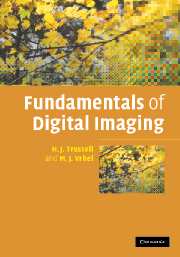Book contents
- Frontmatter
- Contents
- Preface
- Acknowledgments
- 1 Introduction
- 2 Mathematical representation
- 3 Elementary display of images
- 4 Quantization
- 5 Frequency domain representation
- 6 Spatial sampling
- 7 Image characteristics
- 8 Photometry and colorimetry
- 9 Color sampling
- 10 Image input devices
- 11 Image output devices and methods
- 12 Characterization of devices
- 13 Estimation of image model parameters
- 14 Image restoration
- A Generalized functions and sampling representation
- B Digital image manipulation and matrix representation
- C Stochastic images
- D Multidimensional look-up tables
- E Psychovisual properties
- References
- Index
5 - Frequency domain representation
Published online by Cambridge University Press: 06 July 2010
- Frontmatter
- Contents
- Preface
- Acknowledgments
- 1 Introduction
- 2 Mathematical representation
- 3 Elementary display of images
- 4 Quantization
- 5 Frequency domain representation
- 6 Spatial sampling
- 7 Image characteristics
- 8 Photometry and colorimetry
- 9 Color sampling
- 10 Image input devices
- 11 Image output devices and methods
- 12 Characterization of devices
- 13 Estimation of image model parameters
- 14 Image restoration
- A Generalized functions and sampling representation
- B Digital image manipulation and matrix representation
- C Stochastic images
- D Multidimensional look-up tables
- E Psychovisual properties
- References
- Index
Summary
Our first encounters with signals were in the time domain for 1-D signals and the spatial domain for 2-D images. We have seen time domain signals as a graph or as a trace on an oscilloscope. Undergraduate engineers have usually used a spectrum analyzer in the laboratory to characterize signals in the frequency domain. However, almost everyone has seen a graphical representation of an acoustic frequency spectrum when they observe the flashing lights on the spectrum displays of graphic equalizers on higher quality stereo systems. The display shows the observer the relative power of the signal in various frequency ranges.
The interpretation in the frequency domain of audio signals is aided by the fact that the ear is basically a spectrum analyzer. It is easy to interpret the terms high and low frequency when applied to audio signals. We have no difficulty thinking of a rumble as a low-frequency sound, or a screech as a high-frequency sound.
We will have to work a bit to achieve the same associations of visual phenomena with frequency bands. However, be assured that the effort is worthwhile. Among the interpretations that will be shown are that edges are associated with higher frequencies; shading is associated with lower frequencies; blurring is basically a low pass filter, while differentiation is a high pass operation.
Information
- Type
- Chapter
- Information
- Fundamentals of Digital Imaging , pp. 77 - 113Publisher: Cambridge University PressPrint publication year: 2008
